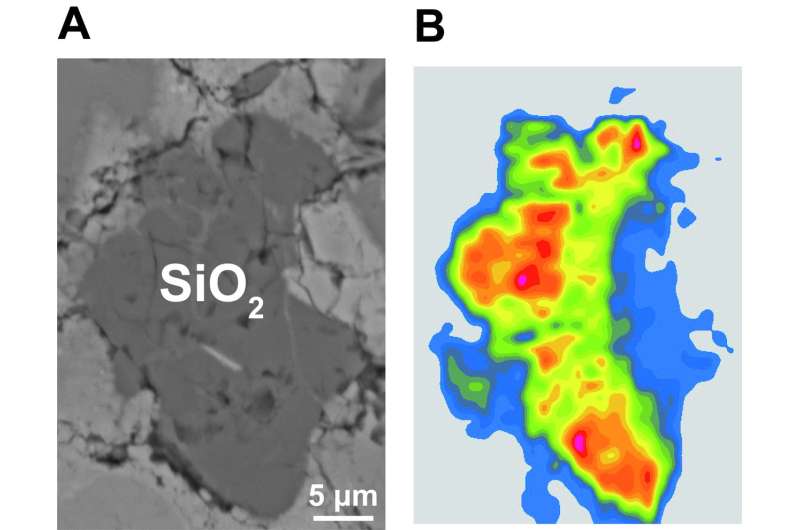May 3, 2018 report
Mineral in lunar meteorite suggests water was once on the moon

A team of researchers led by Masahiro Kayama of Tohoku University has found evidence in a lunar meteorite that water once existed on the moon. In their paper published on the open access site Science Advances, the team describes their study of the meteorite and why they believe it offers evidence of water on the moon.
Water on the moon, some have suggested, would be valuable, because it could support a colony—or perhaps be used for other purposes, such as powering spacecraft. But thus far, efforts to find any below the surface in the more temperate regions have come up empty-handed. In this new effort, the researchers were studying one of the lunar meteorites found on the surface of the Earth. Such meteorites are pieces of the moon blasted into space by an impact. The fragment studied by the team in Japan turned out to be unique—it held some amount of moganite, a mineral that only forms in the presence of water.
Prior research had shown that the meteorite, named NWA 272, crashed into a northern part of Africa approximately 17,000 years ago. Comparison with other moon surface material confirmed it came from the lunar surface, as well. After finding it contained moganite, the team ran more tests to show that it had not formed after landing on Earth.

To explain the presence of the mineral, the team suggests the moon was struck by a comet or other water-bearing object. Some of the water likely evaporated, but some would also have seeped into the lunar surface. As the water sat below the surface, moganite eventually formed. Sometime thereafter, the same area was once again impacted—this time by an object that flung bits of the lunar surface containing the moganite into space. After that, it made its way to Earth.
The researchers suggest their finding is exciting because logic suggests if water were under the surface at one time, more could be there now. It would just be a matter of making the effort to find it.

More information: Masahiro Kayama et al. Discovery of moganite in a lunar meteorite as a trace of H 2 O ice in the Moon's regolith, Science Advances (2018). DOI: 10.1126/sciadv.aar4378
Abstract
Moganite, a monoclinic SiO2 phase, has been discovered in a lunar meteorite. Silica micrograins occur as nanocrystalline aggregates of mostly moganite and occasionally coesite and stishovite in the KREEP (high potassium, rare-earth element, and phosphorus)–like gabbroic-basaltic breccia NWA 2727, although these grains are seemingly absent in other lunar meteorites. We interpret the origin of these grains as follows: alkaline water delivery to the Moon via carbonaceous chondrite collisions, fluid capture during impact-induced brecciation, moganite precipitation from the captured H2O at pH 9.5 to 10.5 and 363 to 399 K on the sunlit surface, and meteorite launch from the Moon caused by an impact at 8 to 22 GPa and >673 K. On the subsurface, this captured H2O may still remain as ice at estimated bulk content of >0.6 weight %. This indicates the possibility of the presence of abundant available water resources underneath local sites of the host bodies within the Procellarum KREEP and South Pole Aitken terranes.
Journal information: Science Advances
© 2018 Phys.org





















